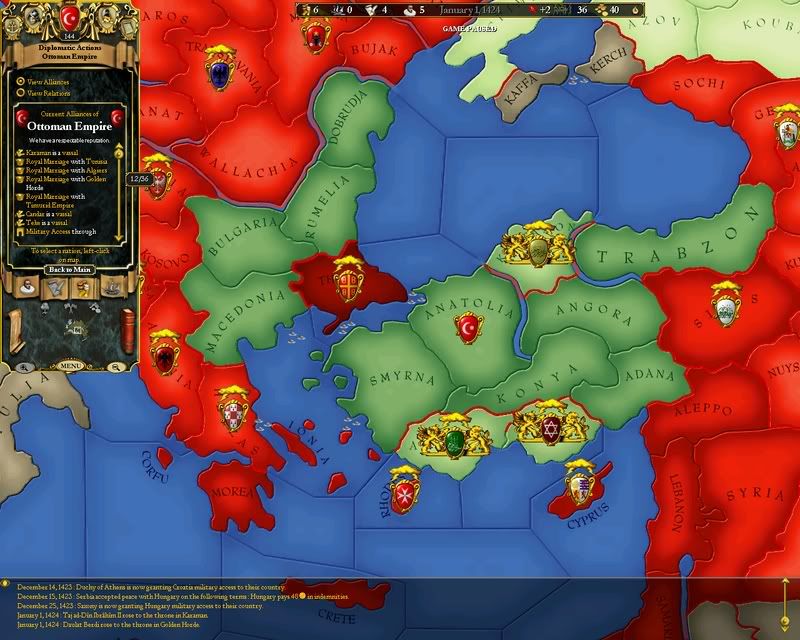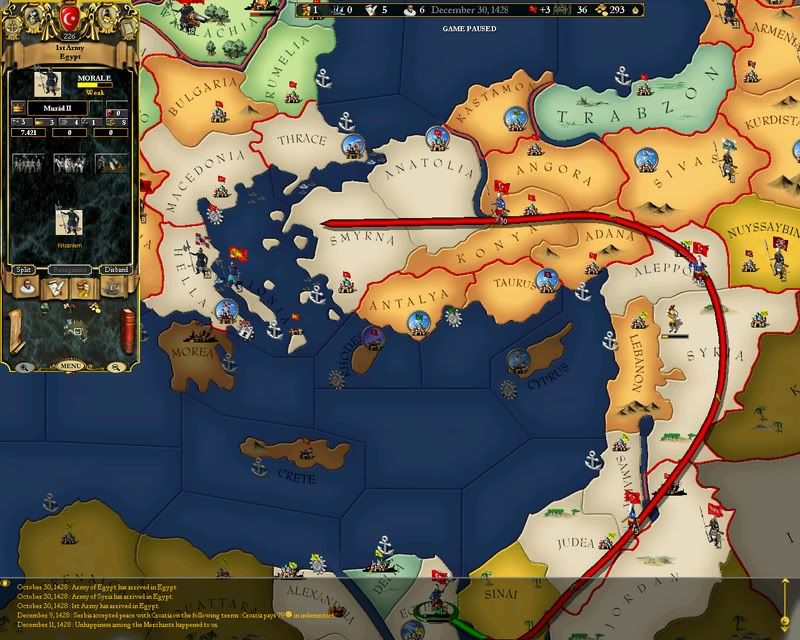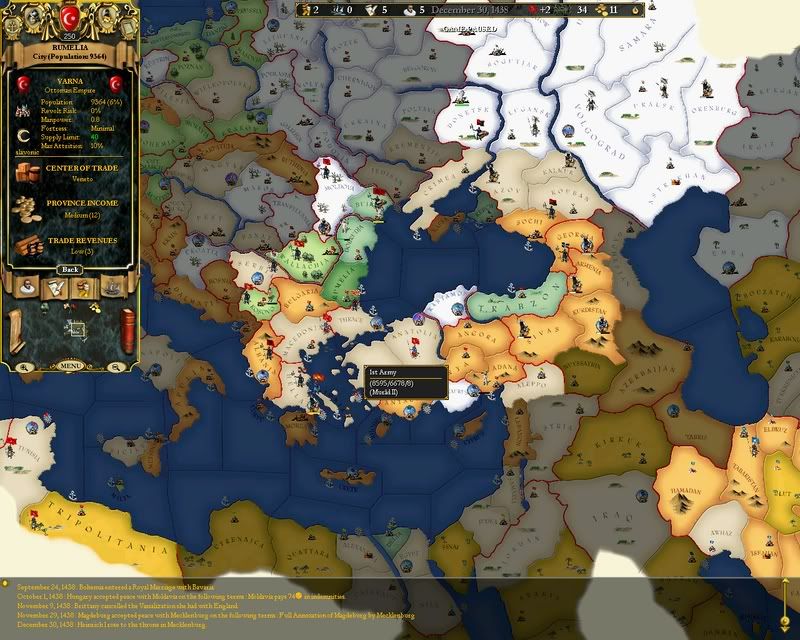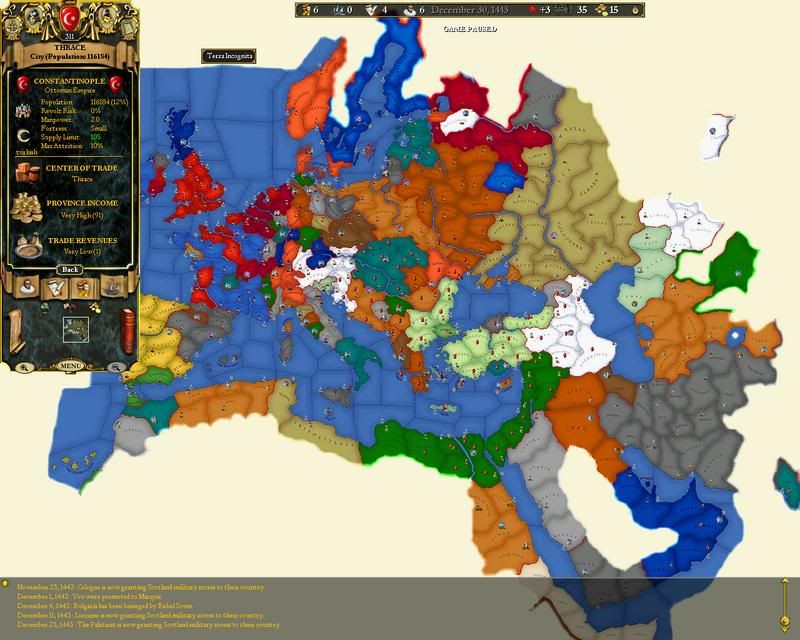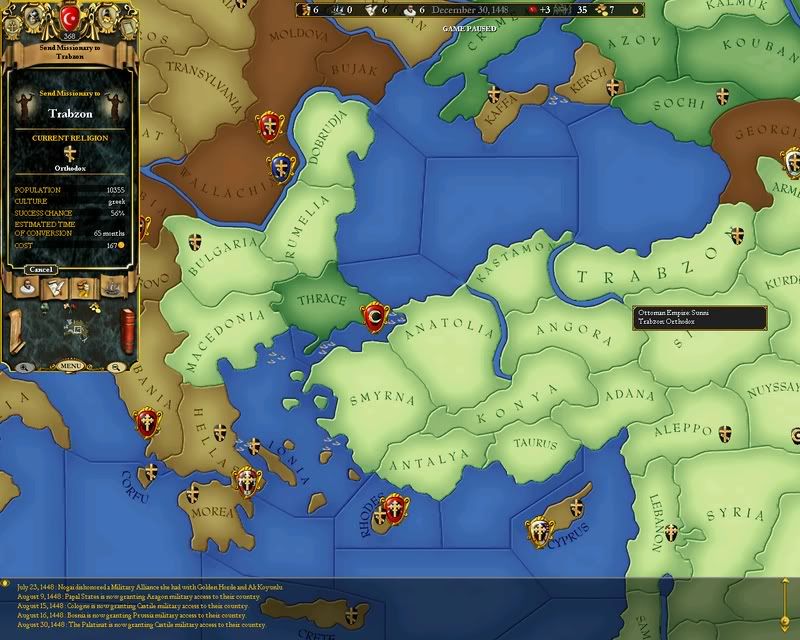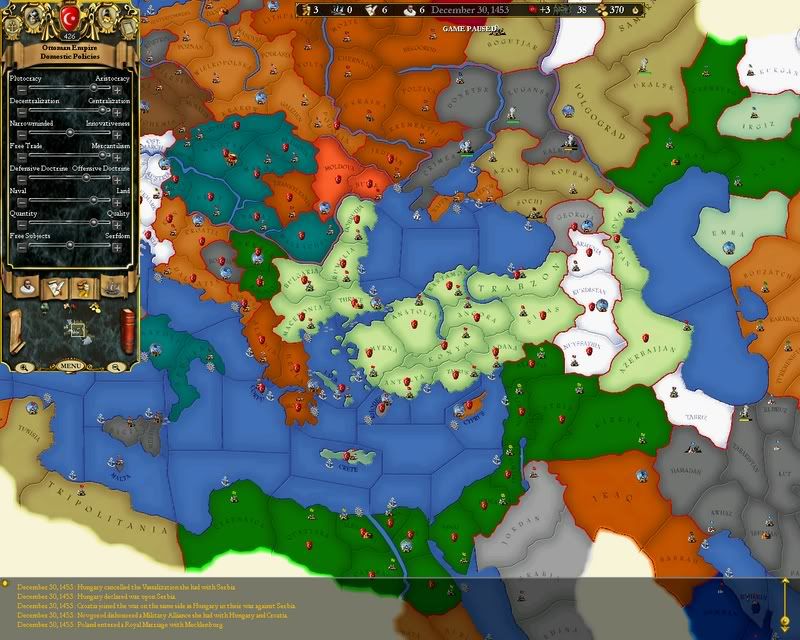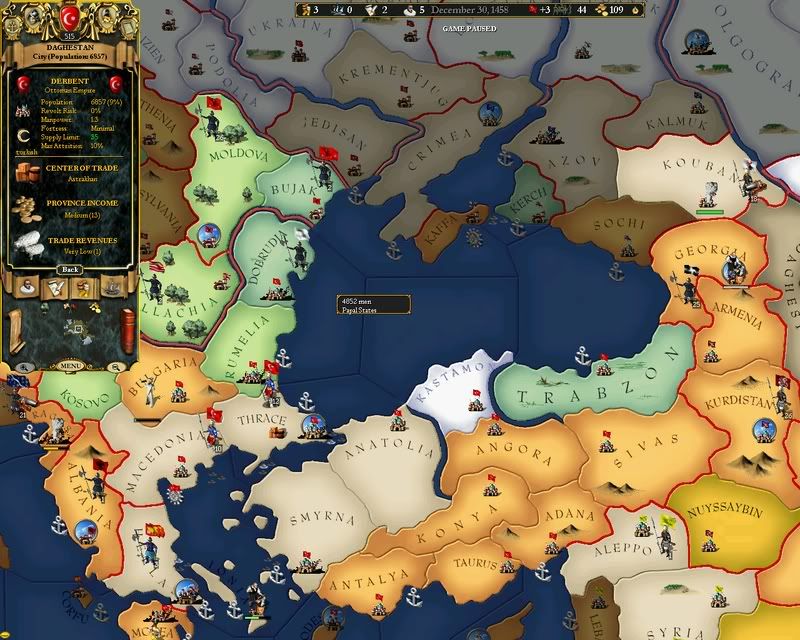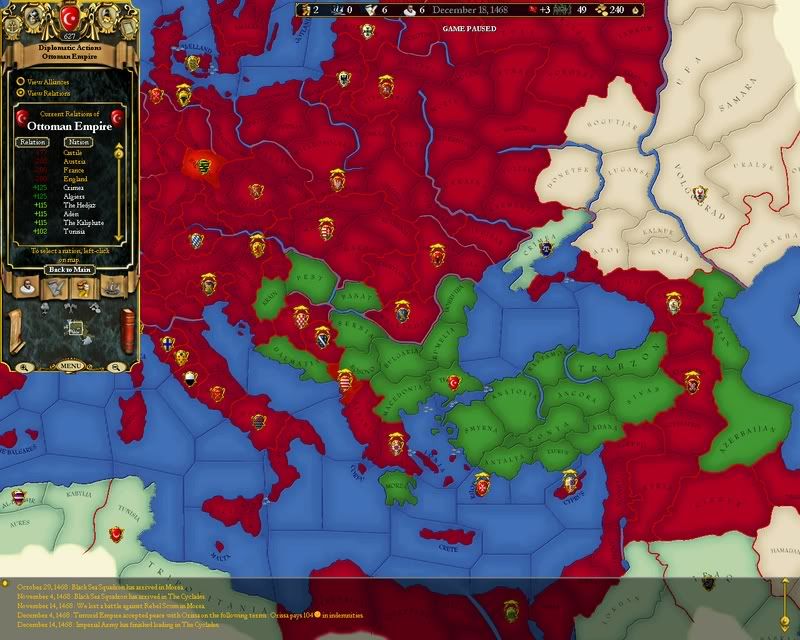Chapter IX - War on the Western Powers (1459-1468)
The Short Polish War
The sultan's taste for blood and more territory is not yet satisfied. He dreams of an expansion into the Adriatic Sea, and when he sees Bosnia besieging Polish Ragusa, he immediately orders an invasion. The invading Turks, led by the sultan, gain control of the siegeforce in Ragusa, and in a few short weeks, the city has surrendered. The Turks try to gain the province in a peace deal, but as the rest of the Poles are hiding behind the Carpathian mountains, the Turks are not able to meet them on open ground.
The sultan soon gets tired of playing with the cowardly Poles, and he decides to let Ragusa go away for 150 ducats. The war ends with no Ottoman expansion, but the treasury is strengthened and Ragusa slips away from Poland anyway, as Bosnians and rebels fight over it following the Turkish withdrawal.
Local rebellions are weakening Imperial control in Konya, but steadfast attacks by the sultan's army break the rebels' hold on central Anatolia. The heretic population of Kosovo also accepted the state religion, something that utterly pleases our sultan. The new war academy has apparently proved its value already as a new splendid military commander has joined the ranks of Ottoman officers. Gedik Ahmed is sure to be a glorious star on the sky of Ottoman war legends.
The Hungarian War
The sultan has just arrived in Kosovo when he is confronted by a messenger who claims to have news of imperial importance. The herald announces that the kingdom of Hungary has declared war against the Ottoman Empire. Their filthy Croatian cousins have also joined as well as some Cypriots. The sultan is utterly shocked by this act of insolence from the Hungarian king, but then he thinks about the exploits possible to gain from the conflict. The sultan immediately orders that 20 000 cavalries be recruited from the newly built Imperial College. This chance shall not slip away from him...
The peace treaty with Poland was signed on March the 1st 1462, and the war declaration by Hungary was made on April the 5th the same year. The peace in the Empire has been scarce lately, but glory awaits our troops on the battlefield. The Turks are getting ready for an epic struggle - over who gets the upper hand in the Balcans, Hungary or Osmania...
The sultan takes his contingent of cavalry north into Serbia, after defeating the defenders, he scouts around and enters Banat. Minor skirmishes in this area occur until the huge Hungarian army closes in on the sultan's task force. He chooses to retreat into Kosovo. Gedik Ahmed takes his troops to the east to fight Hungarian companies besieging Dobrudja. He loses the first battle and moves to Rumelia awaiting fresh recruits from Thrace.
Our vassals in Albania have deceitfully opened their borders to fighting forces from Croatia. The Albanians are on the other hand headed for defeat as the Athenians are treathening to reconquer their lands. The cavalries recuited in Thrace add well to the limited resorces of the sultan. Ahmed also recieves a fair share of the fresh recruits and intends to take revenge on the Hungarians. Mehmed II begins a siege in Serbia, leading a force of 12 000 horsemen. Beograd falls to the sultan in January 1463. The failed conversion of the Bulgars is a thorn in the side for the sultan, but his recent victories in this war is an offset for this annoyance.
While the sultan rushes into the Hungarian plains, Ahmed continues to struggle with the Hungarians in Dobrudja. After being defeated another time, the province surrenders to Hungary. The Hungarian war machine wheels to the northwest as Lithuania has made war on Hungary, what a fortunate incident for the Ottomans. Mehmed II succeeds in several smaller battles against scattered Hungarians in Banat and Pest, and finally lays siege to Banat and Pest during spring time 1463.
The sieges are quick, and as Pest and Banat fall to the Turks, Dobrudja is retaken by Ahmed. By 1464, most of southern Hungary is falling to Osmania, with Odenburg being taken in August 1464. At this time, the sultan feels confident enough to start demanding territories from the Hungarians. His plan is to gain Serbia, Banat and Pest, so that his future territories won from Croatia will not be cut off from the rest of the Empire. The Turkish emissaries return to him with the message of a clear Hungarian 'no'. The war thus has to continue.
During late autumn 1464, the major part of the Turkish strike force is assembled in occupied Pest. The sultan is aware of the huge Hungarian force numbering more than 40 000 troops stationed in Magyar. He needs to do something with this force, or else he will risk to have his task forces eliminated one by one. The winter is particularly harsh, but during spring time, it is decided upon to assault Magyar itself. The army of 25 000, mostly cavalry, is led straight into the Hungarian capital. The battle against 40 000 Hungarians is long to be remembered since the Turks won an astonishing victory. The rest of the Hungarians flee to Maros and Carpatia.
The sultan decides to take down Presburg before occupying Magyar. He moves to the northwest and lays siege to the city. During February 1466, Presburg falls. Time has come to do something with Croatia. Polish forces are already attacking this state, and Gedik Ahmed sets off with 2000 horsemen. He maintains control of the siege command and he takes down Croatia bit by bit.
The siege force in Magyar is victorious in April 1466, and the sultan moves on to Maros. By February 1467, Presburg is retaken by Hungary, while Maros has not yet fallen to the sultan. The continous peace offers by the sultan are refused by the Hungarians. Maros is taken in May, and the sultan moves back to Presburg which is reoccupied in November 1467. The Hungarians are trying to take back Maros and Magyar, but for some reason, they leave their sieges right before the fortresses falls. This is an unexpected but welcome help for the sultan.
Dalmatia, falls, and since both Krain and Croatia are under Ottoman control, the Croatians can not do anything else than accepting the Ottoman peace terms of January 1468. Dalmatia and Krain, in addition to 175 ducats are handed over to the Ottomans. The Hungarians, seeing themselves rather surrounded by the Turks, and left alone by their allies, finally accept the sultan's demands made in February 1468. Serbia, Banat and Pest are ceded to Osmania, forever changing the political balance in the region.
During the war, the subdued peoples of Ragusa and Wallacia declared their independence and made war on their former oppressors, respectively Poland and Hungary. The Ottoman vizier sees these events as beneficial, and hopes to see the provinces fall to weaker powers, such as Bosnia, Athens or Croatia. The Ottomans are bent on dominating the Slavic world. Morea also rebelled during the war, and efforts are made to quell it.
Looking back on the recent decade, the sultan is pleased to see that 5 provinces are added to his realm, as well as seeing his chief enemy considerably weakened.
Osmania by the end of 1468
The sultan is a popular guy...


